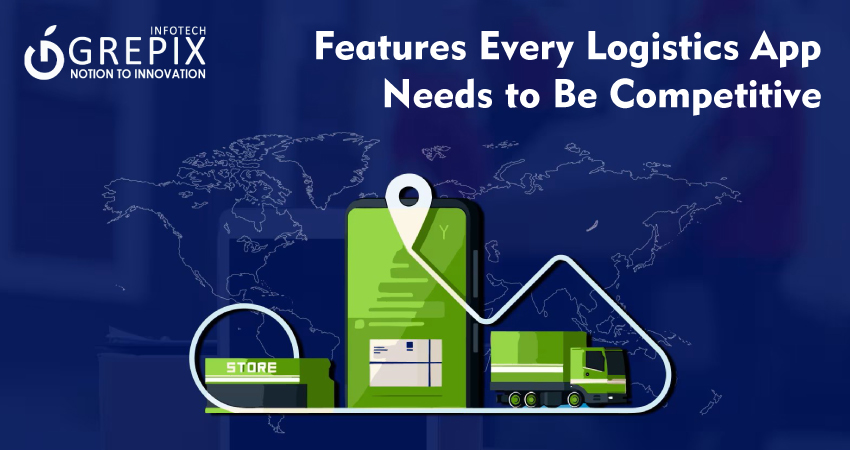Features Every Logistics App Needs to Be Competitive
The global demand for reliable logistics solutions has never been higher. With e-commerce booming and supply chains growing in complexity, the pressure is on. Businesses that leverage advanced logistics app features not only meet these expectations but dominate their markets. Competitive logistics apps and must-have logistics software set the standard for speed, transparency, and efficiency. From fleet management to AI integrations, today’s delivery app essentials enable faster deliveries, real-time data, and seamless operations.
In today’s rapidly evolving supply chain landscape, logistics app features are the cornerstone of successful delivery and freight businesses. This in-depth guide explores must-have logistics software capabilities, from real-time tracking and automated payments to advanced AI, analytics, and seamless user experience. Supported by real-world case studies, up-to-date statistics, and expert insights, this article reveals the delivery app essentials you need to outpace competitors. Discover the secrets behind competitive logistics apps, learn why these features are non-negotiable for modern businesses, and see how the right technology dramatically improves efficiency, customer satisfaction, and revenue growth.
The New Logistics Landscape
The global demand for reliable logistics solutions has never been higher. With e-commerce booming and supply chains growing in complexity, the pressure is on. Businesses that leverage advanced logistics app features not only meet these expectations but dominate their markets. Competitive logistics apps and must-have logistics software set the standard for speed, transparency, and efficiency. From fleet management to AI integrations, today’s delivery app essentials enable faster deliveries, real-time data, and seamless operations.
Why Logistics App Features Matter
- 90% of logistics firms see digital transformation as their top priority for 2025.
- The logistics software market is projected to more than double by 2032, reaching $22.3 billion.
- Route optimization, real-time tracking, and AI-powered analytics are now considered delivery app essentials, not luxuries.
This comprehensive guide will break down the core and advanced features required for must-have logistics software in 2025 and beyond.
Core Features Every Logistics App Needs
Real-Time Tracking: The Heart of Delivery App Essentials
Customers and businesses expect live updates on shipment status. Real-time tracking integrates GPS technology, map APIs, and IoT sensors to deliver up-to-the-minute locations and estimated arrival times.
Key Benefits
- Reduces missed deliveries and customer complaints by 20%.
- Increases transparency for shippers, carriers, and recipients.
- Provides proof-of-delivery and digital signatures for compliance.
Example
A leading customs and freight company deployed a logistics app with real-time tracking, reducing cycle times by 40% and slashing wait times for clients.
Payments & Automated Invoicing: Making Transactions Seamless
Automated payments streamline every transaction in must-have logistics software. These logistics app features simplify complex billing, enable instant payments, and minimize human error.
What to Include
- Multi-mode payment options credit cards, bank transfers, e-wallets.
- Automated invoice generation and reconciliation.
- Real-time payment status notifications and fraud detection.
Real-World Integration
One app integrated escrow payments, ensuring funds were only released upon delivery confirmation. This increased marketplace trust and enabled safer online transactions.
Fleet Management: Smart Control for Competitive Logistics Apps
Effective fleet management is at the core of all competitive logistics apps. These delivery app essentials track vehicle locations, monitor driver performance, and optimize resource usage.
Fleet Features
- GPS fleet tracking for up-to-the-second location data.
- Dispatch control—automated job assignments based on proximity and availability.
- Maintenance scheduling and alerts to reduce vehicle downtime.
Case Study
A B2B logistics app used driver performance dashboards and automated dispatch to cut delivery mistakes by 20% within three months.
Order & Inventory Management: Efficiency at Scale
Modern logistics app features must support end-to-end order and inventory management—another critical pillar of delivery app essentials.
Functions
- Handle the full order lifecycle: from acceptance and dispatch, through delivery, to returns.
- Integrate with warehouse management to track stock levels and automate reorders.
- Real-time inventory reduces out-of-stock and overstock risks.
Industry Application
Farms and perishables suppliers use automated stock management through logistics apps to cut waste and ensure product freshness, supporting just-in-time supply chain principles.
Route Optimization: The Backbone of Must-Have Logistics Software
Intelligent route optimization minimizes delays, cuts fuel costs, and boosts delivery success making it one of the top competitive logistics app features.
Capabilities
- Dynamic rerouting to avoid traffic or weather disruptions.
- AI-powered algorithms for the fastest, most cost-effective paths.
- Multi-stop route planning for large-scale deliveries.
Impact Example
Route optimization tools help logistics teams large and small achieve efficiency gains of up to 30% and reduce operational costs.
Communication Tools: Keeping Everyone Connected
Clear communication is vital for competitive logistics apps. Must-have logistics software includes chat, SMS, or push notification systems.
Benefits
- Instantly inform drivers, customers, and dispatchers of status changes.
- Automated alerts for delays, emergencies, or pickup/drop-off confirmations.
- Improved accountability and customer satisfaction.
Advanced Features for Competitive Logistics Apps
Artificial Intelligence (AI): Smarter, Predictive Operations
AI stands as a defining trait of must-have logistics software. By forecasting demand, optimizing routes, and automating routine tasks, AI drastically enhances logistics app features.
Use Cases
- Predictive analytics for inventory, labor, and delivery scheduling.
- Automated dispatch and matching of carriers with loads.
- Computer vision for inspecting goods and monitoring quality.
Industry Stats
65% of logistics companies have adopted AI-driven solutions, improving efficiency by up to 30%.
Real-Life Example
Amazon uses over 200,000 robots in its warehouses for automated picking, packing, and movement, allowing for high seasonal order volume and increased operational agility.
Advanced Analytics & Reporting: Making Data Actionable
Competitive logistics apps leverage big data analytics to refine operations.
Capabilities
- Real-time dashboards display key performance indicators (KPIs) like on-time deliveries, driver efficiency, and warehouse productivity.
- Automated insights to identify bottlenecks and areas for improvement.
- Customizable reports for internal review or client presentation.
Example
One North American logistics leader reduced their cycle time by 40% after deploying a robust analytics dashboard on their logistics app, leading to faster load processing.
IoT Integrations: The Edge of Must-Have Logistics Software
IoT-enabled logistics app features connect vehicles, warehouses, and even packages to centralized systems for real-time updates throughout the supply chain.
What’s Possible
- Sensors track package condition temperature, humidity, or shock.
- Real-time vehicle monitoring for fuel use, engine health, or tire pressure.
- Automated maintenance alerts when thresholds are crossed.
Blockchain for Secure, Transparent Transactions
Blockchain enhances security and transparency for competitive logistics apps particularly when dealing with multiple carriers and partners.
Key Gains
- Immutable shipment records for regulatory audits.
- Instant payment settlements.
- Transparent contract terms and real-time compliance trails.
Automated Workflow & RPA: Reducing Manual Labor
Robotic Process Automation (RPA) incorporated into logistics software automates routine tasks, from document verification to dispatch assignments.
Impact
- Frees staff from repetitive work, focusing them on exception management.
- Reduces human error and shortens process timelines.
UX Importance: Why User Experience Drives Competitive Logistics Apps
User-Friendly Design: Delivery App Essentials for All Roles
A winning user experience isn’t just a “nice-to-have.” UX is a necessity for must-have logistics software. Whether it's dispatchers, drivers, or customers, an intuitive interface improves adoption and productivity.
For Drivers
- Simple navigation screens.
- One-click access to routes, tasks, and POD (proof of delivery).
- Clear instructions and easy uploads for delivery evidence.
For Dispatchers/Admins
- Dashboard-style interfaces for real-time fleet and delivery overview.
- Drag-and-drop scheduling, auto-assignments, and quick report generation.
- Omnichannel support web, mobile, tablet for anytime, anywhere operations.
For Customers/Business Clients
- Live tracking visuals.
- Instant support chat.
- One-click reorders and repeat shipments.
Example: B2B and B2C Hybrid Apps
Leading platforms use cross-platform frameworks (e.g., Flutter, React Native) for responsive, cross-device UIs, accelerating both deployment and user satisfaction.
Conclusion
Businesses that invest in the right logistics app features position themselves for sustained, competitive advantage. As customer expectations rise and supply chains grow more complex, only those leveraging must-have logistics software and continuously updating features will thrive.
Ready to build or upgrade your logistics app? Partner with a forward-thinking software provider, demand these delivery app essentials, and stay ahead in the fast-paced logistics sector. Share this guide if you found it valuable, and help others discover the must-have logistics software that wins in 2025 and beyond
FAQs
1. What are the delivery app essentials for 2025?
Core logistics app features include real-time tracking, automated payments, intelligent route optimization, and robust fleet and inventory management.
2. How do advanced analytics help competitive logistics apps?
Advanced analytics identify inefficiencies and automate decision-making, which leads to faster deliveries and improved customer satisfaction for logistics firms.
3. How does AI improve must-have logistics software?
AI predicts demand, automates dispatch, and powers real-time route optimization, delivering up to 30% greater operational efficiency.
4. Can small companies afford competitive logistics apps?
Yes cloud-based logistics platforms with modular delivery app essentials allow small businesses to scale up without huge investments.
5. What proof-of-delivery features should be included?
Key PoD features are digital signatures, photo uploads, geo-stamped delivery records, and automated customer notifications.







